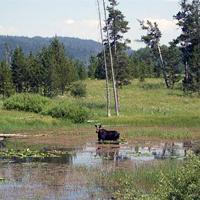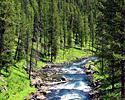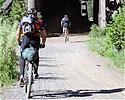
Recently on Cyclingnews.com |
MTB index page for all MTB content
MTB News Feature, June 13, 2008
Divide racers get second option
By Sue George

|
Great Divide Mountain Bike Route (GDMBR) racers now have not just one, but two options for competition this June. Beginning June 20, the more established event known as Great Divide Race, will run north to south for 2,490 miles along the GDMBR across the US from the Canadian border to the Mexican border. In addition, some other hardy souls will compete instead in the Tour Divide starting June 13 in Banff, Canada, and running 2711 miles south to the Mexican border.
Other than dates, the key difference between the two events is that the Tour Divide includes the Canadian section of Adventure Cycling's GDMBR while the Great Divide Race does not.
For the past several years, Matt Lee (SoBe / Cannondale) and some others have been starting the Great Divide Race a day or two early - unofficially racing their own prologue event on the Canadian portion of the trail before the event officially began in the US. When the 37 year-old Lee from Chapel Hill, North Carolina, approached Mike Curiak about adding the Canadian section of the race to the Great Divide race, the answer was "no" with Curiak telling him he wants to maintain the border to border concept of his Great Divide race.
So Lee organized his own version, including the Canadian section, called the Tour Divide.
Lee offered several reasons for the longer Tour Divide. "The race is for the racers, and it is an experience for the riders. I say that if you organize a race and don't include the top 225 miles of the trail, you're not giving the racers the full experience," said Lee. "Last year, we had five people race the prologue. Everyone like it and thought it ought to be in the race. The first 110 mile day is beautiful and scenic. Every year, I see moose and bear."
"I say that if you organize a race and don't include the top 225 miles of the trail, you're not giving the racers the full experience"-Tour Divide organizers Matt Lee on his decision to include the Canadian section of the Great Divide Trail |
"It makes more sense logistically to start in Banff, Canada," added Lee. "You don't have to fly into a small airport with limited resources nearby, including no bikes shops. Starting from Banff makes it easier for international competitors to race. It's 30-40% cheaper to fly into Calgary. Banff is a fantastic mountain bike town and there are shuttles to get there. It's a town with a rich, outdoor history."
For mountain bike access advocates, there is another compelling reason to add the Canadian section. "A portion of the trail runs through Canadian federally designated Wilderness," said Lee. Unlike American federally designated Wilderness, Canadian Wilderness permits mountain biking. "For that reason alone, it's worth honouring the Canadian section. Its wilderness is open to mountain biking."
Lee is no stranger to endurance racing. He has completed the Great Divide Race four times, and 2008 will be his fifth attempt. In 2004, he finished fourth. In 2005 and 2006, he won the event, and last year, he was second. His fastest time for the complete route (including Canadian section) is 17 days, 21 hours and 10 minutes, a Tour Divide record, while Jay Petervary holds the fastest Great Divide Race record (set in 2007, not including Canadian section), with a time of 15 days, 4 hours and 18 minutes. Trish Stevenson holds the women's Great Divide Race Record of 21 days, 23 hours and 47 minutes (2005).
Looking back

|
"The precedent for Divide racing was established by John Stamstad in 1999," said Lee. "At that point, the Great Divide route had been in existence for a year. That was also the year was the first year a woman completed it. That year, Stamstad completed it and established the record."
Stamstad's performance established a few key tenets of Divide Racing, which is unlike any other race. First and foremost, racers compete with only self-support. The idea is self-supported racing is more fair in that it does not favor those with lots of money to buy support. Stamsted's self-supported ride came at a time when ultra-endurance racing was generally supported - think 24 hour racing with pit crews and the Race Across America (RAAM) with follow cars.
"In 2003, Mike Curiak attempted to break the record, riding it as individual time trial," said Lee. "That year, Adventure Cycling also made available the Canadian section of the route. It probably didn't occur to Mike that the Canadian section would be something to race in the future - he focused on the US section - or the border to border concept. It's similar in concept to racing coast to coast."
Curiak dropped out in Steamboat Springs due to mechanical failures in 2003, but as he was planning to do the event in 2004, he publicized it and invited others to join him for a "race". In 2004, Curiak broke Stamsted's record. It was also Lee's first race attempt. Although he finished fourth, he said "I averaged slow speeds, maybe 100 miles per day. I made it my goal to come back the next year and win. When I was researching, I came across the Canadian portion. The more I read about it, the more interested I became in riding the Canadian section as a prologue."
Starting earlier

|
Lee has bumped up the start of the Tour Divide relative to the Great Divide race for several reasons. "The original racing concept according to John Stamstad was you could go for it any time. Most people have to do it in the summer due to snow, and we've chosen June because it works best for academic cycle which means more people can do it." He also noted that in recent years, the snow has been melting faster than it used to at higher elevations plus starting the race a week before the northern hemisphere's summer solstice means cooler temperatures and longer daylight hours in the later part of the race as the race happens more on either side of the solstice.
So with the Tour Divide adding the Canadian section into the race, Cyclingnews wondered if there were any plans to go into Mexico? "The trail, according to Adventure Cycling, begins Banff and runs to Mexico border. It doesn't go into Mexico. There are no plans to go into there. It's perceived as a dangerous territory."
With its new international flair, Lee said the Tour Divide is inspired by the Tour de France. "It's the Grand Tour of mountain bike racing. The average finish time is three weeks. It drops into little towns where people get to interact. Any time you have a Grand Tour, it often travels across borders - like the Tour de France going internationally some years."
Finally, Lee addressed a concern about comparing the times portions of both races that are the same. "Some people are concerned that you can't compare the old times with the new route's times. But it's easy for us to record a US and Canadian time split as racers get a time stamp on their passports when they cross the border. We're considering the GC to include Canada and the US - we'll record both portions as separate stage times."

|
With just a day to go before the start, the Tour Divide had 17 racers signed up, including one woman Mary Paulier. All will be tracked by a new beacon, which will send out a location of latitude and longitude every ten minutes. "When everyone is done, you'll be able to see where everyone has been at 10 minute intervals throughout. There will be all kinds of interesting analyses we can do."
Keeping track
In addition, the Spot brand beacons will show if any racers take short cuts, thereby addressing complaints of previous Divide racers about some racers. In the interest of safety, the beacon has a 911 button to call for help, but Lee has a plan to discourage unnecessary use. "You'll be disqualified from the Tour Divide if you use it, but if it's a life threatening situation, you'll have it to use." The beacons will help those interested in the race follow everyone's progress as the data will show on the race's leaderboard at www.tourdivide.org/leaderboard.
Lee is planning to race the Tour Divide despite a recent wrist injury of torn ligaments. "My goal this year is to average 170 miles per day. Last year, I did 165 miles per day." His secret weapon may be time trial bars, which he said are legal for the event although he never used them before. "I have proudly said that I have never used TT bars because I have seen them as a crossover into roadie scene. However, this year, given the uncertainty with my wrist, I am going to mount some time trial bars. It will indeed be an advantage.
Photography
For a thumbnail gallery of these images, click here
Images by Tour Divide /www.tourdivide.org
- It's not unusual to see moose along the Great Divide Mountain Bike Route.
- Beautiful scenery can help distract racers from the pain.
- The Great Divide Mountain Bike Route features mostly dirt roads.
- The Tour Divide starts in Banff, Canada.
